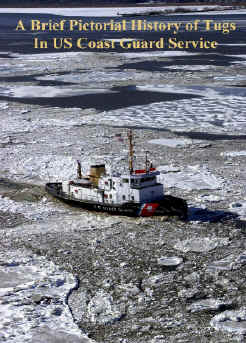

More . . . added Aug 4th 2008
|
|
 |
Prepared and presented by,
When the Coast Guard came into being
in 1915, through the consolidation of the
Revenue Cuuter Service
and the Life Saving Service,
tugs made up a small but significant
portion of the new service’s fleet.
The Acushnet
and
Snohomish
were the two
ocean going tugs of the Coast Guard.
The former served in the |
|
|
|
|
|
|
|
From 1915 until the merger of the Lighthouse Service with the Coast Guard in 1939, the major events which affected the Coast Guard fleet in general and the Tug population in particular, were World War I and the advent of Prohibition. World War I saw the CG population grow to triple its peace time number of personnel. New construction and other acquisitions of tugs saw the tug fleet grow to include a small number of tug like craft classified as Anchorage and Boarding boats (AB’s) as well as 10 former US Navy 88-foot steam tugs. These USN tugs were acquired in 1919 and 1920 and served the CG for varying periods from about 2 years to over 15 years. These tugs displaced 215 tons and were 88’x 20’x8’9” and little has been written about them. They were all named for rivers and below are a listing of these vessels with some limited data on them.
The Volstead Act
became the law of the land in 1920 when the 36th state ratified
the 18th Amendment to the Constitution.
The Coast Guard’s reaction to the new law was cautious and
methodical.
In terms of
shipbuilding and acquisition of vessels things progressed as before until
about 1924 when an enforcement push caused a surge of activity in these
arenas.
True to form
additional tugs were part of the mix.
In 1921 the tug Cable Layer Pequot (later WARC-58) was built for the US Army and acquired by the CG in May 1922. She was built to a tug like design, although she spent almost all of her career, which lasted until the end of WW II, in her intended role laying cable for the CG and later for the US Navy.
|
|
|
|
Tug
Another USSB tug the Leopard
came aboard in 1926.
At
176 tons and 94’ in length she was of medium size and could make about
12 knots.
She served until
1935 when she was sold.
She
spent much of her CG career at the Yard in Curtis Bay, MD and was listed
as 110 feet in length later in her tenure.
Thus she probably received some alterations to her wooden hull
during her CG service.
The 1930’s saw the
beginning of the building program which was the genesis of the
“modern” Coast Guard harbor tug.
Commissioned
in 1934 and 1935 were the four diesel powered 110-foot Tugs of the
A 63-foot class of
tugs was built at
During late 1943
through 1944 a total of 15 64-foot wooden hulled harbor tugs were built
for the Coast Guard. The first 12 were built in NY and the last 3 in
Beginning in the immediate post WW II period a number of former US Navy sea going tugs and salvage vessels were taken into service by the Coast Guard. First came two former Fleet Tugs of the Navajo class. These were just the first two of six sisters of this numerous class of 205-foot steel work horse tugs to find their way into CG service. The other 4 would come into CG service later on. They were acquired in pairs in 1956 and 1980. At about the same time, right after the war (1946) two 213-foot Diver class salvage ships were also taken into CG service and would be joined by a 3rd sister ship in 1980. Finally in 1959 two 143-foot former USN ATA’s (originally built as ATR’s) were commissioned in the Coast Guard. They were the last type of former Navy tugs to be acquired and would serve until 1979 and 1980.
The next
large class of CG tugs are the 65-footers of the Capstan
class.
Fifteen in all were
built by three different yards in
Finally we have probably
the most familiar class of CG Tugs in service today, the 140-foot Bay
class WTGB icebreaking tugs.
While
all were built at
|
|
BIBLIOGRAPHY
Photographs
and Documents from the National Archives; Primarily Record Group 26
General
Information from Websites: Fred’s Place:
http://www.fredsplace.org/ And from: Coast Guard Tug Association: http://www.cg-tugs.org/
|
|
|
|
About
the Author:
New Additions - Thank you Jim Flynn
|